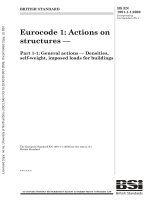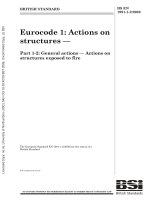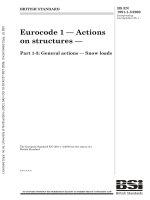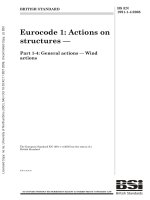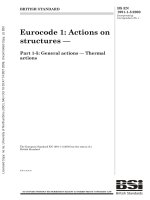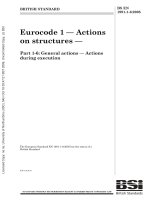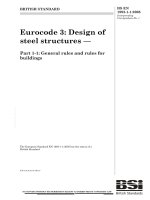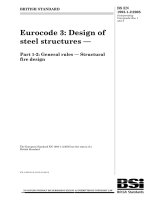Tiêu chuẩn Châu Âu EC6: Kết cấu gạch đá phần 1.2: Kết cấu chịu lửa (Eurocode6 EN1996 1 2 e 2005 Design of masonry structures part 1.2: General rules and structural fire design)
Bạn đang xem bản rút gọn của tài liệu. Xem và tải ngay bản đầy đủ của tài liệu tại đây (932.77 KB, 81 trang )
EN 1996-1-2
EUROPEAN STANDARD
NORME EUROPÉENNE
EUROPÄISCHE NORM
May 2005
ICS 13.220.50; 91.010.30; 91.080.30
Supersedes ENV 1996-1-2:1995
English version
Eurocode 6 - Design of masonry structures - Part 1-2: General
rules - Structural fire design
Eurocode 6 - Calcul des ouvrages en maçonnerie - Partie
1-2: Règles générales - Calcul du comportement au feu
Eurocode 6 - Bemessung und Konstruktion von
Mauerwerksbauten - Teil 1-2: Allgemeine Regeln Tragwerksbemessung für den Brandfall
This European Standard was approved by CEN on 4 November 2004.
CEN members are bound to comply with the CEN/CENELEC Internal Regulations which stipulate the conditions for giving this European
Standard the status of a national standard without any alteration. Up-to-date lists and bibliographical references concerning such national
standards may be obtained on application to the Central Secretariat or to any CEN member.
This European Standard exists in three official versions (English, French, German). A version in any other language made by translation
under the responsibility of a CEN member into its own language and notified to the Central Secretariat has the same status as the official
versions.
CEN members are the national standards bodies of Austria, Belgium, Cyprus, Czech Republic, Denmark, Estonia, Finland, France,
Germany, Greece, Hungary, Iceland, Ireland, Italy, Latvia, Lithuania, Luxembourg, Malta, Netherlands, Norway, Poland, Portugal, Slovakia,
Slovenia, Spain, Sweden, Switzerland and United Kingdom.
EUROPEAN COMMITTEE FOR STANDARDIZATION
COMITÉ EUROPÉEN DE NORMALISATION
EUROPÄISCHES KOMITEE FÜR NORMUNG
Management Centre: rue de Stassart, 36
© 2005 CEN
All rights of exploitation in any form and by any means reserved
worldwide for CEN national Members.
B-1050 Brussels
Ref. No. EN 1996-1-2:2005: E
EN1996-1-2:2005
Contents
Page
Foreword .................................................................................................................................... 4
Background of the Eurocode programme................................................................................4
Status and field of application of Eurocodes ...........................................................................5
National Standards implementing Eurocodes..........................................................................6
Links between Eurocodes and products harmonised technical specifications (ENs and
ETAs).......................................................................................................................................6
Additional information specific to EN 1996-1-2.....................................................................7
National Annex for EN 1996-1-2 ............................................................................................9
Section 1. General...................................................................................................................... 9
1.1 Scope .................................................................................................................................9
1.2 Normative references.......................................................................................................10
1.3 Assumptions ....................................................................................................................11
1.4 Distinction between Principles and application Rules ....................................................11
1.5 Definitions .......................................................................................................................11
1.5.1 Special terms relating to fire design in general.................................................................................... 12
1.5.2 Special terms relating to calculation methods...................................................................................... 13
1.6 Symbols ...........................................................................................................................13
Section 2. Basic principles and rules ....................................................................................... 15
2.1 Performance requirement ................................................................................................15
2.1.1 General................................................................................................................................................. 15
2.1.2 Nominal fire exposure ......................................................................................................................... 15
2.1.3 Parametric fire exposure ...................................................................................................................... 16
2.2 Actions.............................................................................................................................16
2.3 Design values of material properties ...............................................................................16
2.4 Assessment methods........................................................................................................17
2.4.1 General................................................................................................................................................. 17
2.4.2 Member analysis................................................................................................................................. 18
2.4.3 Analysis of part of the structure........................................................................................................... 20
2
EN1996-1-2: 2005
2.4.4 Global structural analysis..................................................................................................................... 20
Section 3. Materials ................................................................................................................ 20
3.1 Units.................................................................................................................................20
3.2 Mortar ..............................................................................................................................20
3.3 Mechanical properties of masonry ..................................................................................20
3.3.1 Mechanical properties of masonry at normal temperature................................................................... 20
3.3.2 Strength and deformation properties of masonry at elevated temperature........................................... 21
3.3.2.1 General.......................................................................................................................................... 21
3.3.2.2 Unit mass ...................................................................................................................................... 21
3.3.3 Thermal properties............................................................................................................................... 21
3.3.3.1 Thermal elongation ....................................................................................................................... 21
3.3.3.2 Specific heat capacity ................................................................................................................... 21
3.3.3.3 Thermal conductivity.................................................................................................................... 21
Section 4. Design Procedures for obtaining fire resistance of masonry walls ......................... 21
4.1 General information on the design of walls.....................................................................21
4.1.1 Wall types by function......................................................................................................................... 21
4.1.2 Cavity walls and untied walls comprising independent leaves ............................................................ 22
4.2 Surface finishes – rendering mortar and plaster. .............................................................24
4.3 Additional requirements for masonry walls ....................................................................24
4.4 Assessment by testing......................................................................................................24
4.5 Assessment by tabulated data ..........................................................................................25
4.6 Assessment by calculation...............................................................................................25
Section 5. Detailing.................................................................................................................. 25
5.1 General.............................................................................................................................25
5.2 Junctions and joints .........................................................................................................26
5.3 Fixtures, pipes and cables................................................................................................26
Annex A (Informative) Guidance on selection of fire resistance periods ............................... 28
Annex B (Normative) Tabulated fire resistance of masonry walls.......................................... 29
Annex C (Informative) Simplified calculation model ............................................................ 63
Annex D (Informative) Advanced calculation method........................................................... 71
Annex E (Informative) Examples of connections that meet the requirements of Section 5... 78
3
EN1996-1-2:2005
Foreword
This document (EN 1996-1-2:2005) has been prepared by Technical Committee CEN/TC 250
"Structural Eurocodes", the secretariat of which is held by BSI.
This European Standard shall be given the status of a national standard, either by publication
of an identical text or by endorsement, at the latest by November 2005 and conflicting national
standards shall be withdrawn at the latest by March 2010.
This document supersedes ENV 1996-1-2:1995.
CEN/TC 250 is responsible for all Structural Eurocodes.
Background of the Eurocode programme
In 1975, the Commission of the European Community decided on an action programme in the
field of construction, based on article 95 of the Treaty. The objective of the programme was
the elimination of technical obstacles to trade and the harmonisation of technical
specifications.
Within this action programme, the Commission took the initiative to establish a set of
harmonised technical rules for the design of construction works which, in a first stage, would
serve as an alternative to the national rules in force in the Member States and, ultimately,
would replace them.
For fifteen years, the Commission, with the help of a Steering Committee with
Representatives of Member States, conducted the development of the Eurocodes programme,
which led to the first generation of European codes in the 1980’s.
In 1989, the Commission and the Member States of the EU and EFTA decided, on the basis
of an agreement1 between the Commission and CEN, to transfer the preparation and the
publication of the Eurocodes to the CEN through a series of Mandates, in order to provide
them with a future status of European Standard (EN). This links de facto the Eurocodes with
the provisions of all the Council’s Directives and/or Commission’s Decisions dealing with
European standards (e.g. the Council Directive 89/106/EEC on construction products - CPD and Council Directives 93/37/EEC, 92/50/EEC and 89/440/EEC on public works and services
and equivalent EFTA Directives initiated in pursuit of setting up the internal market).
The Structural Eurocode programme comprises the following standards generally consisting
of a number of Parts:
EN 1990
EN 1991
EN 1992
EN 1993
EN 1994
1
4
Eurocode :
Eurocode 1:
Eurocode 2:
Eurocode 3:
Eurocode 4:
Basis of Structural Design
Actions on structures
Design of concrete structures
Design of steel structures
Design of composite steel and concrete structures
Agreement between the Commission of the European Communities and the European Committee for Standardisation (CEN) concerning
the work on EUROCODES for the design of building and civil engineering works (BC/CEN/03/89).
EN1996-1-2: 2005
EN 1995
EN 1996
EN 1997
EN 1998
EN 1999
Eurocode 5:
Eurocode 6:
Eurocode 7:
Eurocode 8:
Eurocode 9:
Design of timber structures
Design of masonry structures
Geotechnical design
Design of structures for earthquake resistance
Design of aluminium structures
Eurocode standards recognise the responsibility of regulatory authorities in each Member
State and have safeguarded their right to determine values related to regulatory safety matters
at national level where these continue to vary from State to State.
Status and field of application of Eurocodes
The Member States of the EU and EFTA recognise that EUROCODES serve as reference
documents for the following purposes:
- as a means to prove compliance of building and civil engineering works with the essential
requirements of Council Directive 89/106/EEC, particularly Essential Requirement N°1 –
Mechanical resistance and stability – and Essential Requirement N°2 – Safety in case of fire;
- as a basis for specifying contracts for construction works and related engineering services;
- as a framework for drawing up harmonised technical specifications for construction
products (ENs and ETAs)
The Eurocodes, as far as they concern the construction works themselves, have a direct
relationship with the Interpretative Documents2 referred to in Article 12 of the CPD, although
they are of a different nature from harmonised product standards3. Therefore, technical
aspects arising from the Eurocodes work need to be adequately considered by CEN Technical
Committees and/or EOTA Working Groups working on product standards with a view to
achieving full compatibility of these technical specifications with the Eurocodes.
The Eurocode standards provide common structural design rules for everyday use for the
design of whole structures and component products of both a traditional and an innovative
nature. Unusual forms of construction or design conditions are not specifically covered and
additional expert consideration will be required by the designer in such cases.
2
3
According to Art. 3.3 of the CPD, the essential requirements (ERs) shall be given concrete form in interpretative documents for the
creation of the necessary links between the essential requirements and the mandates for harmonised ENs and ETAGs/ETAs.
According to Art. 12 of the CPD the interpretative documents shall :
a)
give concrete form to the essential requirements by harmonising the terminology and the technical bases and indicating classes or
levels for each requirement where necessary ;
b)
indicate methods of correlating these classes or levels of requirement with the technical specifications, e.g. methods of calculation and
of proof, technical rules for project design, etc. ;
c)
serve as a reference for the establishment of harmonised standards and guidelines for European technical approvals.
The Eurocodes, de facto, play a similar role in the field of the ER 1 and a part of ER 2.
5
EN1996-1-2:2005
National Standards implementing Eurocodes
The National Standards implementing Eurocodes will comprise the full text of the Eurocode
(including any annexes), as published by CEN, which may be preceded by a National title
page and National foreword, and may be followed by a National Annex.
The National Annex may only contain information on those parameters which are left open
in the Eurocode for national choice, known as Nationally Determined Parameters, to be used
for the design of buildings and civil engineering works to be constructed in the country
concerned, i.e. :
- values and/or classes where alternatives are given in the Eurocode,
- values to be used where a symbol only is given in the Eurocode,
- country specific data (geographical, climatic, etc.), e.g. snow map,
- the procedure to be used where alternative procedures are given in the Eurocode,
and it may also contain
- decisions on the application of informative annexes,
- references to non-contradictory complementary information to assist the user to apply the
Eurocode.
Links between Eurocodes and products harmonised technical specifications (ENs and
ETAs)
There is a need for consistency between the harmonised technical specifications for
construction products and the technical rules for works4. Furthermore, all the information
accompanying the CE Marking of the construction products which refer to Eurocodes should
clearly mention which Nationally Determined Parameters have been taken into account.
This European Standard is part of EN 1996 which comprises the following parts:
EN 1996-1-1: Common rules for reinforced and unreinforced masonry structures.
EN 1996-1-2: General Rules - Structural Fire Design.
EN 1996-2: Design, Selection of materials and execution of masonry
EN 1996-3: Simplified calculation methods and simple rules for masonry structures
EN 1996-1-2 is intended to be used together with EN 1990, EN 1991-1-2, EN 1996-1-1, EN
1996-2 and EN 1996-3
4
6
see Art.3.3 and Art.12 of the CPD, as well as clauses 4.2, 4.3.1, 4.3.2 and 5.2 of ID 1.
EN1996-1-2: 2005
Additional information specific to EN 1996-1-2
The general objectives of fire protection are to limit risks with respect to the individual and
society, neighbouring property, and where required, directly exposed property, in the case of
fire.
The Construction Products Directive 89/106/EEC gives the following essential requirement
for the limitation of fire risks:
"The construction works must be designed and built in such a way that, in the event of an
outbreak of fire
- the load bearing resistance of the construction can be assumed for a specified period of
time
- the generation and spread of fire and smoke within the works are limited
- the spread of fire to neighbouring construction works is limited
- the occupants can leave the works or can be rescued by other means
- the safety of rescue teams is taken into consideration".
According to the Interpretative Document No 2 "Safety in Case of Fire" the essential
requirement may be observed by following various possibilities for fire safety strategies
prevailing in the Member States like conventional fire scenarios (nominal fires) or 'natural'
(parametric) fire scenarios, including passive and/or active fire protection measures.
The fire parts of Structural Eurocodes deal with specific aspects of passive fire protection in
terms of designing structures and parts thereof for adequate load bearing resistance that could
be needed for safe evacuation of occupants and fire rescue operations and for limiting fire
spread as relevant.
Required functions and levels of performance are generally specified by the national
authorities - mostly in terms of a standard fire resistance rating. Where fire safety engineering
for assessing passive and active measures is acceptable, requirements by authorities will be
less prescriptive and may allow for alternative strategies.
This Part 1-2, together with EN 1991-1-2, Actions on structures exposed to fire, supplements
EN 1996-1-1, so that the design of masonry structures can comply with normal and fire
requirements.
Supplementary requirements concerning, for example
- the possible installation and maintenance of sprinkler systems
- conditions on occupancy of building or fire compartment
- the use of approved insulation and coating materials, including their maintenance
are not given in this document, as they are subject to specification by the competent authority.
7
EN1996-1-2:2005
A full analytical procedure for structural fire design would take into account the behaviour of
the structural system at elevated temperatures, the potential heat exposure and the beneficial
effects of active fire protection systems, together with the uncertainties associated with these
three features and the importance of the structure (consequences of failure).
At the present time it is possible to perform a calculation procedure for determining adequate
performance which incorporates some, if not all, of these parameters and to demonstrate that
the structure, or its components, will give adequate performance in a real building fire.
However the principal current procedure in European countries is one based on results from
standard fire resistance tests. The grading system in regulations, which call for specific
periods of fire resistance, takes into account (though not explicitly), the features and
uncertainties described above.
Due to the limitations of the test method, further tests or analyses may be used. Nevertheless,
the results of standard fire tests form the bulk of input for calculation procedures for structural
fire design. This standard therefore deals principally with the design for the standard fire
resistance.
Application of this Part 1-2 of Eurocode 6 with the thermal actions given in EN 1991-1-2, is
illustrated in figure 0.1. For design according to this part, EN 1991-1-2 is required for the
determination of temperature fields in structural elements, or when using general calculation
models for the analysis of the structural response.
Project Design
Prescriptive Rules
(Thermal actions given by Nominal fire)
Tabular
data
Member
analysis
Analysis of part
of the structure
Analysis of
entire structure
Calculation of
actions at
boundaries
Calculation of
action effects
at boundaries
Selection of actions
Simple calculation
models
Advanced calculation
models
Simple calculation
models
Advanced calculation
models
Advanced calculation
models
Performance-Based Code
(Physically based thermal actions)
Selection of
simple or advanced fire models
Member
analysis
Analysis of part
of the structure
Analysis of entire
structure
Calculation of
actions
at boundaries
Calculation of
action effects
at boundaries
Selection of actions
Simple calculation
models
Advanced calculation Advanced calculation
models
models
Figure 0.1 : Design procedures
8
Advanced calculation
models
EN1996-1-2: 2005
Where simple calculation models are not available, the Eurocode fire parts give design
solutions in terms of tabular data (based on tests or general calculation models), which may
be used within the specified limits of validity.
National Annex for EN 1996-1-2
This standard gives alternative procedures, values and recommendations for classes, with
notes indicating where national choices may have to be made. Therefore the National
Standard implementing EN 1996-1-2 should include a National annex which contains all
Nationally Determined Parameters to be used for the design of buildings and civil engineering
works constructed in the relevant country.
National choice is allowed in EN 1996-1-2 through clauses:
- 2.2 (2)
Actions;
- 2.3 (2)
Design values of material properties;
- 2.4.2 (3)
Member analysis;
- 3.3.3.1(1) Thermal elongation;
- 3.3.3.2 (1) Specific heat;
- 3.3.3.3
Thermal conductivity;
- 4.5(3)
Value of γGlo;
- Annex B Tabulated values of fire resistance of masonry walls;
- Annex C Values of constant c.
Section 1. General
1.1 Scope
(1)P This Part 1-2 of EN 1996 deals with the design of masonry structures for the accidental
situation of fire exposure, and is intended to be used in conjunction with EN 1996-1-1, EN
1996-2, 1996-3 and EN 1991-1-2. This part 1-2 only identifies differences from, or
supplements to, normal temperature design.
(2)P This Part 1-2 deals only with passive methods of fire protection. Active methods are not
covered.
(3)P This Part 1-2 applies to masonry structures which, for reasons of general fire safety, are
required to fulfil certain functions when exposed to fire, in terms of:
- avoiding premature collapse of the structure (load bearing function)
- limiting fire spread (flames, hot gases, excessive heat) beyond designated areas
(separating function)
9
EN1996-1-2:2005
(4)P This Part 1-2 gives principles and application rules for designing structures for specified
requirements in respect of the aforementioned functions and levels of performance.
(5)P This Part 1-2 applies to structures, or parts of structures, that are within the scope of
EN 1996-1-1, EN 1996-2 and EN 1996-3 and are designed accordingly.
(6)P This Part 1-2 does not cover masonry built with Natural Stone units to EN771-6
(7)P This Part 1-2 deals with the following:
- non-loadbearing internal walls.
- non-loadbearing external walls.
- loadbearing internal walls with separating or non-separating functions.
- loadbearing external walls with separating or non-separating functions.
1.2 Normative references
This European standard incorporates by dated or undated references, provisions from other
publications. These Normative references are cited at appropriate places in the text and the
publications are listed hereafter. For dated references, subsequent amendments to, or
revisions of, any of these publications apply to this European Standard only when
incorporated in it by amendment or revision. For undated references, the latest edition of the
publication referred to applies (including amendments).
EN 771-1
Specification for masonry units - Part 1: Clay masonry units.
EN 771-2
Specification for masonry units - Part 2: Calcium silicate masonry units
EN 771-3
Specification for masonry units - Part 3: Aggregate concrete masonry units
(dense and light-weight aggregates)
EN 771-4
Specification for masonry units - Part 4: Autoclaved aerated concrete masonry
units
EN 771-5
Specification for masonry units - Part 5: Manufactured stone masonry units
EN 771-6
Specification for masonry units - Part 6 : Natural stone units
EN 772-13 Methods of test for masonry units - Part 13: Determination of net and gross dry
density of masonry units (except for natural stone)
EN 998-1
Specification for mortar for masonry - Part 1: Rendering and plastering mortar
EN 998-2
Specification for mortar for masonry - Part 2: Masonry mortar.
EN 1363
Fire resistance
Part 1: General requirements
Part 2: Alternative and additional requirements
10
EN1996-1-2: 2005
EN 1364
Fire resistance tests of non-loadbearing elements.
Part 1 Walls
EN 1365
Fire resistance tests of loadbearing elements.
Part 1 Walls
EN 1365
Fire resistance tests of loadbearing elements.
Part 4 Columns
EN 1366
Fire resistance tests for service installations.
Part 3 Penetration seals
EN 1990
Basis of design for Structural Eurocodes
EN 1991
Basis of design and actions on structures:
Part 1-1: General actions - Densities, self-weight, imposed loads for buildings
Part 1-2: Actions on structures exposed to fire;
EN 1996
Design of masonry structures:
Part 1.1: Common rules for reinforced and unreinforced masonry structures
Part 2: Design, selection of materials and execution of masonry
Part 3: Simplified and simple rules for masonry structures
prEN 12602 Prefabricated reinforced components.of autoclaved aerated concrete
Annex C – Resistance to fire design of AAC components and structures
EN 13279-1 Gypsum and gypsum-based building plaster - Part 1: Definitions and requirements
1.3 Assumptions
(1) P In addition to the general assumptions of EN 1990 the following assumptions apply:
- Any passive fire protection systems taken into account in the design will be adequately
maintained.
- The choice of the relevant design fire scenario is made by appropiately qualified and
experienced personnel.
1.4 Distinction between Principles and application Rules
(1) The rules given in EN 1990 clause 1.4 apply.
1.5 Definitions
For the purposes of this Part 1-2 of EN 1996, the definitions of EN 1990 and of EN 1991-1-2
apply with the following additional definitions:
11
EN1996-1-2:2005
1.5.1 Special terms relating to fire design in general
1.5.1.1
Fire protection material
Any material or combination of materials applied to a structural member for the purpose of
increasing its fire resistance
1.5.1.2
Fire wall
A wall separating two spaces (generally two fire compartments or buildings) which is
designed for fire resistance and structural stability, including resistance to mechanical impact
(Criterion M) such that, in the case of fire and failure of the structure on one side of the wall,
fire spread beyond the wall is avoided (so that a Fire wall is designated REI-M or EI-M)
NOTE: In some countries a fire wall has been defined as a separating wall between fire compartments without a
requirement for resistance to mechanical impact; the definition above should not be confused with this more
limited one. Fire walls may have to fulfil additional requirements not given in this part 1-2, these being given in
the regulations of each country
1.5.1.3
Loadbearing wall
A flat, membrane-like component predominantly subjected to compressive stress, for
supporting vertical loads, for example floor loads, and also for supporting horizontal loads,
for example wind loads.
15.1.4
Non-loadbearing wall
A flat membrane-like building component loaded predominantly only by its dead weight, and
which does not provide bracing for loadbearing walls. It may however, be required to transfer
horizontal loads acting on its surface to loadbearing building components such as walls or
floors.
1.5.1.5
Separating wall
A wall exposed to fire on one side only.
1.5.1.6
Non-separating wall
A loadbearing wall exposed to fire on two or more sides.
1.5.1.7
Normal temperature design
The ultimate limit state design for ambient temperatures in accordance with Part 1-1 of EN
1992 to 1996 or ENV 1999
1.5.1.8
Part of structure
The isolated part of an entire structure with appropriate support and boundary conditions.
12
EN1996-1-2: 2005
1.5.2 Special terms relating to calculation methods
1.5.2.1
Ineffective cross section
The area of a cross section that is assumed to become ineffective for fire resistance purposes.
1.5.2.2.
Effective cross section
The cross section of a member used in structural fire design, obtained by removing parts of
the cross section with assumed zero strength and stiffness.
1.5.2.3.
Residual cross section
That part of the cross section of the original member which is assumed to remain after
deduction of the thickness which is ineffective for fire-resistance purposes.
1.5.2.4
Structural failure of a wall in the fire situation
When the wall loses its ability to carry a specified load after a certain period of time
1.5.2.5
Maximum stress level
For a given temperature, the stress level at which the stress-strain relationship of masonry is
truncated to a yield plateau.
1.6 Symbols
For the purpose of this Part 1-2, the following symbols apply, in addition to those given in EN
1991-1-1 and EN 1991-1-2:
E 30 or E 60,. . ., member meeting the integrity criterion, E, for 30, or 60 .. minutes in
standard fire exposure.
I 30 or I 60,. . ., member meeting the thermal insulation criterion, I, for 30, or 60 .. minutes
in standard fire exposure.
M 90 or M 120,. . ., member meeting the mechanical resistance criterion, M, for 90, or 120 ..
minutes after standard fire exposure when mechanical impact applied .
R 30 or R 60,. . ., member meeting the load bearing criterion, R, for 30, or 60 .. minutes in
standard fire exposure,
A
total area of masonry
Am
surface area of a member per unit length;
Ap
area of the inner surface of the fire protection material per unit length of the
member;
Aθ1
area of masonry up to temperature θ1;
Aθ2
area of masonry between temperatures θ1 and θ2;
13
EN1996-1-2:2005
14
c
constant obtained from stress strain tests at elevated temperature (with subscripts)
ca
specific heat capacity of masonry;
ct
combined thickness of webs and shells (given as a percentage of the width of a
unit)
e∆θ
eccentricity due to variation of temperature across masonry;
fb
characteristic unit strength
fdθ1
design compressive strength of masonry at less than or equal to θ1;
fdθ2
design strength of masonry in compression between θ1 and θ2°C
hef
effective height of the wall
l
length at 20°C ;
lF
length of a wall for a period of fire resistance
NEd
design value of the vertical load;
NRd,fiθ2
design value of the resistance in fire;
NRk
characteristic value of vertical resistance of masonry wall or column;
nvg
no value given
tF
thickness of a wall for a period of fire resistance
tfi,d
time of fire classification (eg 30 minutes) for a standard fire in accordance with
EN 1363;
tFr
thickness of the cross-section whose temperature does not exceed θ2
α
proportion of load on a wall;
αt
coefficient of thermal expansion of masonry
εT
thermal strain
γGlo
a safety factor for use in fire tests;
∆t
time interval;
ηfi
reduction factor for design load level in the fire situation;
θ1
temperature up to which the cold strength of masonry may be used;
θ2
temperature above which any residual masonry strength is ignored;
λa
thermal conductivity;
EN1996-1-2: 2005
µ0
degree of utilisation at time t = 0.
ρ
gross dry density of the masonry units, measured in accordance with EN 772- 13.
Section 2. Basic principles and rules
2.1 Performance requirement
2.1.1 General
(1)P Where mechanical resistance is required, structures shall be designed and constructed in
such a way that they maintain their loadbearing function during the relevant fire exposure.
(2)P Where compartmentation is required, the elements forming the boundaries of the fire
compartment, including joints, shall be designed and constructed in such a way that they
maintain their separating function during the relevant fire exposure, i.e.
- no integrity failure shall occur, in order to prevent the passage of flames and hot gases
through the member, and to prevent the occurrence of flames on the unexposed side
- no insulation failure shall occur in order to limit the temperature rise of the unexposed
face within specified levels.
-
when required, resistance to mechanical impact (M)
-
when required, limitation of the thermal radiation from the unexposed side.
(3)P Deformation criteria shall be applied where the means of protection, or the design
criteria for separating elements, requires consideration of the deformation of the load bearing
structure.
(4) Consideration of the deformation of the load bearing structure is not necessary in the
following case:
- the separating elements have to fulfil requirements according to a nominal fire exposure.
2.1.2 Nominal fire exposure
(1)P For the standard fire exposure, members shall comply with criteria, R (mechanical
resistance). E (integrity), I (insulation) and M (mechanical impact) as follows:
- Loadbearing only
criterion R
- Separating only
criteria EI
- Separating and loadbearing
criteria REI
- Loadbearing, separating and mechanical impact
criteria REI-M
- Separating and mechanical impact
criteria EI-M
15
EN1996-1-2:2005
(2) Criterion R is assumed to be satisfied when the load bearing function is maintained
throughout the required time of fire exposure.
(3) Criterion I is assumed to be satisfied when the mean temperature of the unexposed face
does not rise by more 140 ºK, and the maximum temperature rise at any point of that surface
does not exceed 180 ºK
(4) Criterion E is assumed to be satisfied when the passage of flames and hot gases through
the member is prevented.
(5) Where a vertical separating element, with or without a load-bearing function, is required
to comply with an impact resistance requirement, (criterion M), the element should resist the
application of the horizontal concentrated load specified in EN 1363 Part 2.
(6) With the external fire exposure curve the same criteria as (1)P should apply, however the
reference to this specific curve should be identified by the letters “ef”.
2.1.3 Parametric fire exposure
(1) The load-bearing function is satisfied when collapse is prevented for the complete
duration of the fire, including the decay phase, or for a prescribed period of time.
(2) The separating function, with respect to insulation, is satisfied when the following criteria
are met:
- the mean temperature rise over the whole of the non-exposed surface does not exceed
140ºK and the maximum temperature rise of that surface at any point does not exceed 180ºK,
at the time of the maximum gas temperature,
- the mean temperature rise over the whole of the non-exposed surface does not exceed
180ºK, and the maximum temperature rise at any point of that surface does not exceed 220ºK
during the decay phase of the fire or up to a required period of time.
2.2 Actions
(1)P The thermal and mechanical actions shall be obtained from EN 1991-1-2.
(2) The emissivity of a masonry surface should be taken as εm.
NOTE: The value to be ascribed to εm in a Country may be found in its National Annex. The value will depend on
the material of the masonry.
2.3 Design values of material properties
(1)P Design values of the mechanical (material strength and deformation) properties, Xd,fi, are
defined as follows:
Xd,fi = kθ Xk / γM,fi
(2.1)
where:
Xk
16
is the characteristic value of the strength or deformation property of the material (eg
fk) for normal temperature design to EN 1996-1-1;
EN1996-1-2: 2005
kθ
is the reduction factor for the strength or deformation property
dependent on the material temperature;
γM,fi
is the partial safety factor for the relevant material property, for the fire situation.
(Xk,θ / Xk) ,
(2)P Design values of the thermal properties, Xd,fi, of materials are defined as follows:
(i) if an increase of the property is favourable for safety:
Xd,fi = Xk,θ / γM,fi
(2.2a)
or
(ii) if an increase of the property is unfavourable for safety:
Xd,fi = γM,fi X k,θ
(2.2b)
where:
X k,θ
is the value of the material property in fire design, generally dependent on the
material temperature, (see section 3);
NOTE: The value of γM,fi to be ascribed in a Country may be found in its National Annex. For thermal properties
of masonry the recommended value of the partial safety factor γM,fi for the fire situation is 1,0. For mechanical
properties of masonry, the recommended value of the partial safety factor γM,fi for the fire situation is 1,0.
2.4 Assessment methods
2.4.1 General
(1)P The model of the structural system adopted for design in the fire situation shall reflect
the expected performance of the structure in fire.
(2)P The analysis for the fire situation may be carried out using one of the following:
- testing the structure
- tabulated data
- member analysis
- analysis of part of the structure
- global structural analysis
(3)P It shall be verified for the relevant duration of fire exposure that
Efi,d ≤ Rfi,t,d
(2.3)
Where
Efi,d
is the design effect of actions for the fire situation, determined in accordance
with EN 1991-1-2, including the effects of thermal expansion and deformation
Rfi,t, d is the corresponding design resistance in the fire situation.
17
EN1996-1-2:2005
(4) The structural analysis for the normal situation should be carried out in accordance with
EN 1990 5.1.4(2).
(5) In order to verify standard fire resistance requirements, a member analysis is sufficient.
(6) Where application rules given in this Part 1-2 are only valid for the standard temperaturetime curve, this is identified in the relevant clauses
(7)P Tabulated data given in this part is based on the standard temperature-time curve in
accordance with EN 1363.
(8)P As an alternative to design by calculation, fire resistance may be based on the results of
fire tests, or on fire tests in combination with calculation (see EN1990 5.2).
2.4.2 Member analysis
(1) The effect of actions should be determined for time t=0 using combination factors ψ1,1 or
ψ2,1 according to EN 1991-1-2.
(2) As a simplification to (1), the effect of ψ2,1 on actions Ed,fi may be obtained from a
structural analysis for normal temperature design as:
Ed,fi = ηfi Ed
(2.4)
where:
Ed
is the design value of the corresponding force or moment for normal temperature
design, for a fundamental combination of actions (see EN 1990);
ηfi
is the reduction factor for the design load level for the fire situation.
(3) The reduction factor ŋfi for load combination (6.10) in EN 1990 should be taken as:
ηfi =
G k +ψ fi Q k,1
γ G G k + γ Q,1 Q k,1
(2.5)
or for load combinations (6.10a) and (6.10b) in EN 1990 as the smaller value given by the
two following expressions:
ηfi =
ηfi =
G k +ψ fi Q k,1
γ G G k + γ Q,1ψ 0,1 Q k,1
G k +ψ fi Q k,1
ξ γ G G k + γ Q,1 Q k,1
where:
18
Qk,1
is the principal variable load;
Gk
is the characteristic value of a permanent action;
(2.5a)
(2.5b)
EN1996-1-2: 2005
γG
is the partial factor for permanent actions;
γQ,1
is the partial factor for variable action 1;
ψfi
is the combination factor for frequent values, given either by ψ1,1 or ψ2,1
ξ
is a reduction factor for unfavourable permanent actions G.
NOTE 1: An example of the variation of the reduction factor ηfi versus the load ratio Qk,1/Gk for different values
of the combination factor ψfi = ψ1,1 according to expression (2.5) is shown in the figure to this note with the
following assumptions: γGA = 1,0, γG = 1,35 and γQ = 1,5. Use of expressions (2.5a) and (2.5b) will give figures
slightly higher than those in the figure.
The values of partial factors for use in a Country may be found in its National Annex. Recommended values are
given in EN 1990. The choice of expression (6.10) or (6.10)a and (6.10)b may also be found in the National
Annex.
η fi
0,8
0,7
0,6
ψ 1,1 = 0,9
0,5
ψ 1,1 = 0,7
ψ 1,1 = 0,5
0,4
ψ 1,1 = 0,2
0,3
0,2
0,0
0,5
1,0
1,5
2,0
2,5
3,0
Q k,1 / G k
Variation of the reduction factor ηfi with the load ratio Qk,1 / Gk
NOTE 2: As a simplification the recommended value of ηfi = 0,65 may be used, except for imposed load
category E as given in EN 1990 (areas for storage and industrial activity) for which the recommended value is
0,7.
(4) Only the effects of thermal deformations resulting from thermal gradients across the
cross-section need to be considered. The effects of axial or in-plane thermal expansions may
be neglected.
(5) The boundary conditions at supports and ends of a member may be assumed to remain
unchanged throughout the fire exposure.
(6) Tabulated data, simplified or advanced calculation methods are suitable for verifying
members under fire conditions.
NOTE: Annexes B, C and D give information on tabulated data, simplified and advanced calculation methods.
19
EN1996-1-2:2005
2.4.3 Analysis of part of the structure
(1) The effect of actions should be determined for time t=0 using combination factors ψ1,1 or
ψ2,1 according to EN 1991-1-2.
(2) As an alternative to carrying out a structural analysis for the fire situation at time t = 0,
the reactions at supports and internal forces and moments at boundaries of part of the
structure may be obtained from a structural analysis for normal temperature as given in
2.4.1(4)
(3) The part of the structure to be analysed should be specified on the basis of the potential
thermal expansions and deformations, such that their interaction with other parts of the
structure can be approximated by time-independent support and boundary conditions during
fire exposure.
(4)P Within the part of the structure to be analysed, the relevant failure mode in fire exposure,
the temperature-dependent material properties and member stiffnesses, effects of thermal
expansions and deformations (indirect fire actions) shall be taken into account
(5) The boundary conditions at supports and forces and moments at boundaries of part of the
structure may be assumed to remain unchanged throughout the fire exposure.
2.4.4 Global structural analysis
(1)P When global structural analysis for the fire situation is carried out, the relevant failure
mode in fire exposure, the temperature-dependent material properties and member stiffness,
effects of thermal expansions and deformations (indirect fire actions) shall be taken into
account.
Section 3. Materials
3.1 Units
(1) The requirements for masonry units given in EN 1996-1-1 apply to this Part with the
following addition:
- Group 1S: Units containing less than 5% of formed voids by volume; additionally,they
may contain indentations, for example frogs, grip holes or grooves in the bed face, if such
indentations will be filled with mortar in the finished wall.
3.2 Mortar
(1) The requirements for mortar given in EN 1996-1-1 apply to this Part.
3.3 Mechanical properties of masonry
3.3.1 Mechanical properties of masonry at normal temperature
(1)P The mechanical properties of masonry at 20°C shall be taken as those given in EN 19961-1 for normal temperature design.
20
EN1996-1-2: 2005
3.3.2 Strength and deformation properties of masonry at elevated temperature
3.3.2.1 General
(1) The strength and deformation properties of masonry at elevated temperatures may be
obtained from the stress-strain relationship obtained by tests for a project or from a database.
NOTE: Stress-strain relationships for some materials are given in Annex D. These sress strain relationships are
valid for heating rates between 2 and 50 K/min.
3.3.2.2 Unit mass
(1) The unit mass of masonry may be considered to be independent of the masonry
temperature. The density of masonry can be obtained from the density of the masonry
materials, as given in EN 1991-1-1.
NOTE: The density of masonry units and mortar should be declared by the manufacturer in accordance with
ENs 771-1 to 5 and EN 998-2.
3.3.3 Thermal properties
3.3.3.1 Thermal elongation
(1) The thermal elongation of masonry should be determined from tests or from a database.
NOTE: The variation of the thermal elongation with temperature for some materials is given in Annex D; values
may be found in the National Annex.
3.3.3.2 Specific heat capacity
(1) The specific heat capacity of masonry, ca, should be determined from tests or from a
database.
NOTE 1: The variation of the specific heat capacity with temperature for some materials is given in Annex D
NOTE 2: The value of ca to be used in a Country may be found in its National Annex.
3.3.3.3 Thermal conductivity
(1) The thermal conductivity, λa, should be determined from tests or from a database.
NOTE 1: The variation of the thermal conductivity with temperature for some materials is given in Annex D
NOTE 2: The value of λa to be used in a Country may be found in its National Annex.
Section 4. Design Procedures for obtaining fire resistance of masonry walls
4.1 General information on the design of walls
4.1.1 Wall types by function
(1) For fire protection, a distinction is made between non-loadbearing walls and loadbearing
walls, and between separating walls and non-separating walls.
21
EN1996-1-2:2005
(2) Separating walls serve to prevent fire propagation from one place to another, and are
exposed to fire on one side only. Examples are walls along escape ways, walls of stair wells,
separating walls of a fire compartment.
(3) Non-separating loadbearing walls are subjected to fire on two or more sides. Examples are
walls within a fire compartment.
(4) External walls may be separating walls, or non-separating walls as required.
NOTE: External separating walls less than 1,0 m in length should be treated as non-separating walls for the
purposes of fire design, depending on the adjacent construction.
(5) Walls which include lintels above openings should have at least the same fire resistance as
if there was no lintel in the wall.
(6) Fire walls are separating walls that are required to resist mechanical impact in addition to
actions REI, or EI, as relevant.
NOTE: Examples of fire walls are walls separating buildings or fire compartments.
(7) Stiffening elements, such as cross walls, floors, beams, columns or frames, should have at
least the same fire resistance as the wall.
NOTE: If assessment shows that the failure of the stiffening elements on one side of a fire wall would not lead to
a failure of the fire wall the stiffening elements do not need fire resistance.
(8) Additional factors to be considered for fire design are:
- the use of non-combustible materials
- the effect on a fire wall from thermal reaction or expansion of an adjacent construction
situated close to the fire wall.
- the effect on a wall of displacement, in a fire, of columns and beams close to the wall.
4.1.2 Cavity walls and untied walls comprising independent leaves
(1) When both leaves of a cavity wall are loadbearing and carry approximately equal loads,
the fire resistance of a cavity wall with leaves of approximately equal thickness is defined as
the fire resistance of an equivalent single leaf wall of thickness equal to the sum of the
thicknesses of the two leaves, (see figure 4.1, A), providing that no combustible material is
included in the cavity.
22
EN1996-1-2: 2005
1
1
2
2
A: Cavity wall (both leaves loaded)
B: Cavity wall (one leaf loaded)
1
3
C: Cavity wall (non-loadbearing)
D: Untied wall
(loadbearing or non-loadbearing)
Key
1: Wall ties or bed joint reinforcement
2: Cavity unfilled or partially filled;
3: Untied wall
Figure 4.1: Illustration of cavity walls and double leaf walls
(2) When only one leaf of a cavity wall is loadbearing, the resistance of the cavity wall is
usually greater than the fire resistance achieved for the loadbearing leaf when considered to
act as a single leaf wall, (see figure 4.1, B).
(3) The fire resistance of a cavity wall comprising two non-loadbearing leaves (Figure 4.1, C)
may be taken as the sum of the fire resistances of the individual leaves, limited to a maximum
of 240 min when fire resistance is determined by this Part of EN1996-1-2.
23
EN1996-1-2:2005
(4) For untied walls comprising independent leaves, the fire resistance of the wall is
determined by reference to the appropriate loadbearing or non-loadbearing table in Annex B
for the single leaf wall (see figure 4.1, D) which is to be assessed as being exposed to fire.
4.2 Surface finishes
(1) The fire resistance of masonry walls may be increased by the application of a layer of a
suitable surface finish, for example:
- gypsum premixed plaster in accordance with EN 13279-1
- plaster type LW or T in accordance with EN 998-1
For cavity and untied walls, the surface finish is only needed on the outside faces of the
leaves, and not between the two leaves.
(2) An additional masonry leaf or masonry cladding may be used to increase the fire
resistance of a wall.
4.3 Additional requirements for masonry walls
(1)P Any supporting, or stiffening, part of a structure shall have at least the same fire
resistance as the structure being supported.
(2) Combustible thin damp proof materials incorporated into a wall may be ignored in
assessing fire resistance.
(3) Masonry units containing holes through the unit should not be laid so that the holes are at
right angles to the face of the wall, i.e. the wall should not be penetrated by the holes of the
masonry units.
(4) When thermal insulation systems made of insulation and plaster are used on single leaf
external walls, it should be noted that:
- insulation layers made of combustible materials do not enhance fire resistance,
- insulation layers made of non-combustible materials, e.g. mineral wool or foamed glass,
can be used instead of a suitable surface finish. [Rob, deleted render, as it is not considered to
be a suitable finish!]
4.4 Assessment by testing
(1) For all types of masonry walls the fire resistance may be obtained from tests made in
accordance with the relevant ENs (see 1.2 for a list of test methods). Guidance on selection of
fire resistance periods is given in Annex A.
(2) Tests on masonry walls should be carried out if the fire resistance of the masonry to be
used (masonry units, percentage of holes, density, dimension), type of mortar (general
purpose mortar, lightweight or thin layer mortar) or the combination of units and mortar is not
available already.
NOTE: Values of fire resistance may be available in a database.
24
EN1996-1-2: 2005
4.5 Assessment by tabulated data
(1) Assessment of masonry walls may be carried out using the tables, in Annex B, which give
the minimum thickness of masonry required, for the relevant criterion, to achieve the stated
period of fire resistance, when constructed using units of the material, Group and density
given.
(2) In the tables, the minimum wall thickness given is for fire resistance purposes only. The
thickness required for other considerations as defined in EN 1996-1-1, or which is needed to
meet other requirements, for example acoustic performance, is not taken into account.
(3) The tabulated values for loadbearing walls are valid for a total characteristic vertical load
of (α NRk)/γGlo where α, the ratio of the applied design load on the wall to the design
resistance of the wall, is 1,0 or 0,6 and where NRk is taken as Φfkt (see EN 1996-1-1).
NOTE: The value of γGlo to be used in a Country may be found in its National Annex. The tables in the NOTE to
Annex B have been obtained from the consideration of test results wherein γGlo was 3 to 5; fire tests, before the
advent of partial factor design, were subjected to the permissible load, which was, approximately, the
characteristic strength divided by the global factor γF× γM ,where γF and γM are partial factors for actions and
materials respectively (see EN 1990 and EN 1996-1-1).
4.6 Assessment by calculation
(1) The fire resistance of masonry walls may be assessed by calculation, taking into account
the relevant failure mode in fire exposure, the temperature dependent material properties, the
slenderness ratio and the effects of thermal expansions and deformations.
(2) The calculation method may be:
- a model for specific types of member
or
- a global structural analysis simulating the behaviour of structural members, part of a
skeleton or the entire structure.
(3) The validity of calculation methods should be assessed by comparison of calculated fire
resistance with the results of tests.
NOTE 1: A simplified method of calculation for walls is given in Annex C.
NOTE 2: An advanced method of calculation for walls is given in Annex D.
Section 5. Detailing
5.1 General
(1)P The detailing of masonry in a structure shall not reduce the fire resistance of the
construction.
25
